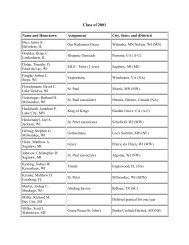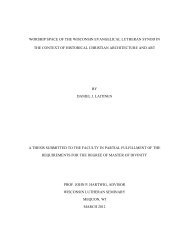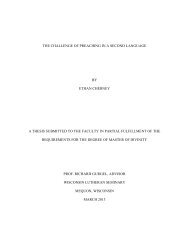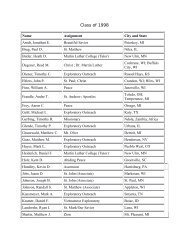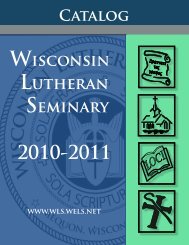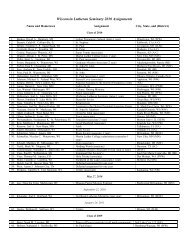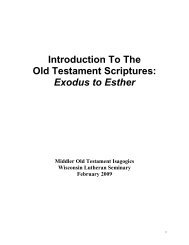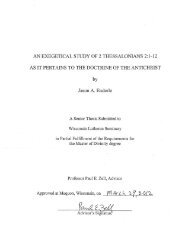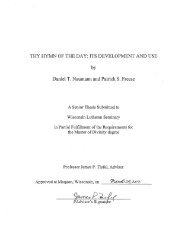Untitled - Wisconsin Lutheran Seminary - WELS
Untitled - Wisconsin Lutheran Seminary - WELS
Untitled - Wisconsin Lutheran Seminary - WELS
You also want an ePaper? Increase the reach of your titles
YUMPU automatically turns print PDFs into web optimized ePapers that Google loves.
gives in this letter. The fact that Paul calls it a mystery does not indicate that it must remain a<br />
mystery until the end. Paul’s words are words of warning and encouragements to be watchful.<br />
Gordon Fee clings too tightly to the word “mystery” and dismisses any application of Paul’s<br />
words when he writes: “All speculations about later applications to one’s own present realities,<br />
whether it be Luther’s to the pope or twentieth-century North Americans’ to Hitler or Russian<br />
communism, are idle speculations. From our present distance the best position would seem to<br />
be, ‘Wait and see.’” 71 This attitude of “wait and see” seems to capture the sentiment of some<br />
commentators and exegetes – simply one of watchfulness and anticipation for this great<br />
Antichrist to finally come.<br />
This mystery “is at work” (ἐνεργεῖται). The verb is a present middle indicative from<br />
ἐνεργέω. The middle voice is always used with an impersonal subject; here “the secret force of<br />
lawlessness is at work,” that is, it is in operation. The word is also often used of supernatural<br />
working. Green states, “Paul does not suggest that this secret power is divine but only that it is<br />
supernatural, and, according to the context, malignant and satanic.”<br />
The masculine form of the verb κατέχω is used here, ὁ κατέχων. Present-day readers do<br />
not know what this restraining force is, but its purpose is known. The verb form would take a<br />
supplied object, simply the pronoun “it,” to refer back to the “mystery of lawlessness” previously<br />
stated. This person will “restrain” or “hold back” the “mystery of lawlessness.” Stated earlier<br />
were the interpretations and suggestions of what this restraining force, both neuter and<br />
masculine, could be. Lenski suggests an answer to why both the masculine and neuter are used:<br />
“The collective or general sense of the neuter (here τὸ κατέχον) refers to all the elements or<br />
powers in the hands of the persons involved who are here named by the masculine ὁ κατέχων.” 73<br />
Speaking of this personal force, Paul says that “it would be removed” (ἐκ μέσου γένηται).<br />
The prepositional phrase ἐκ μέσου (“from among”) in itself implies removal. This phrase is<br />
72<br />
71 Gordon D. Fee, The First and Second Letters to the Thessalonians (Grand Rapids, MI: Wm. B.<br />
Eerdmans Publishing Co., 2009), 288.<br />
72 Gene L. Green, The Letters to the Thessalonians (Grand Rapids, MI: Wm. B. Eerdmans Publishing Co.,<br />
2002), 317.<br />
73 R.C.H. Lenski, The Interpretation of St. Paul’s Epistles to the Colossians, to the Thessalonians, to<br />
Timothy, to Titus and to Philemon (Minneapolis, MN: The Wartburg Press, 1946), 419.<br />
36




